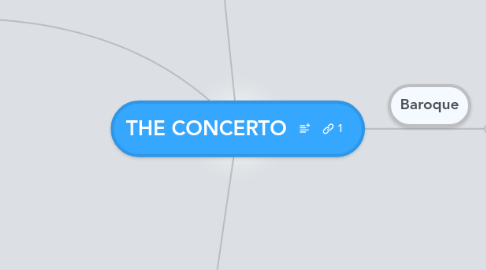
1. Classical (1730 - 1800)
1.1. Age of Enlightenment
1.1.1. Rise in freelance musicians
1.1.1.1. increased importance of reputation
1.2. Aesthetics
1.2.1. Embodied an overlap of aesthetic phenomena
1.2.1.1. Grand
1.2.1.2. Virtuoso
1.2.1.3. Intimate
1.2.2. many composers over-concentrated on the virtuoso aspect and wrote vapid material
1.2.3. hybrid of ritornello form & sonata form
1.2.4. hybrid of ritornello form & sonata form
1.3. Wolfgang Amadeus Mozart
1.3.1. imbued the concerto genre with greater aesthetic display than before
1.3.2. explored greater use of the keyboard and novel methods in dividing material between hands
1.3.3. The Cadenza
1.3.3.1. now a substantial section of considerable length to allow the soloist to demonstrate his artistry
1.3.3.2. no longer a mere embellishment
1.3.3.3. begin to quote earlier music material or themes
1.3.3.4. Mozart wrote and published his cadenzas
1.3.3.5. now a substantial section of considerable length to allow the soloist to demonstrate his artistry
1.3.4. Solo - orchestra relationship
1.3.4.1. dialogue
1.3.4.1.1. re-introduced the orchestra as the antagonist or co-protagonist that makes dialogue with the soloist
1.3.4.1.2. cooperation - conflict - cooperation (general pattern)
2. Romantic (1800s)
2.1. Industrial Revolution
2.1.1. Rise in urbanisation
2.1.1.1. people wanted to be dazzled by pyrotechnics and high level virtuosity
2.2. Post French Revolution
2.2.1. Enlightenment ideals got increasingly discredited/ Counter-Enlightenment
2.2.1.1. reason cannot solve all human problems
2.2.1.2. value in the individual and subjective
2.2.1.3. expression of one's uniqueness
2.2.1.4. artist-hero
2.3. Ludwig Van Beethoven
2.3.1. highlighting the opposition between the soloist and ensemble
2.3.2. soloist is portrayed as a dramatic protagonist
2.3.3. showcased higher level of virtuosity and brilliance as the keyboard developed
2.3.4. Beethoven instructs performers to play the cadenza according to the score; soloists are not given the freedom to improvise
2.3.5. made use of attacca
2.4. Felix Mendelssohn
2.4.1. pushed the concerto forward into the ideals of romanticism
2.4.2. No more 4R3S structure
2.4.3. unified solo and tutti exposition
2.4.4. cadenza is written into the flow of the music
2.4.5. cyclicism
2.5. Niccolo Paginini
2.5.1. incomparable technical virtuosity
2.6. Franz Liszt
2.6.1. first to appear solo for an entire concert
2.6.1.1. introduced the instrumental recital
2.6.2. improvisation based on familiar themes
2.6.3. cyclicism
2.6.4. thematic transformation
2.7. Absolute Music
2.7.1. art
2.7.1.1. symphonic concerto
2.7.1.1.1. traditional
2.7.1.1.2. non-traditional
2.7.2. entertainment
2.7.2.1. virtuoso concerto
2.8. Programmatic Music
2.9. Hector Berlioz
2.9.1. predecessor of Liszt
2.9.2. recognisable musical archetypes
2.9.3. idee fixe
3. 20th Century
3.1. Post WW1
3.2. Developments
3.2.1. term 'concerto' was loosely used
3.2.1.1. basically an indication of instrumentation
3.2.1.2. no formal formats or models
3.3. Sergei Rachmaninoff
3.3.1. wrote concerti as tools to express his own skills
3.3.2. theme and variation
3.4. Bela Bartok
3.4.1. folk influences
3.4.1.1. modal quality
3.5. Incorporation of Jazz
3.5.1. trendy in Europe
3.5.2. began as a reaction against Germanism
3.5.3. Maurice Ravel
3.5.4. George Gershwin
4. Baroque
4.1. Early Baroque (1600 - early 1700)
4.1.1. Stile concertato
4.1.1.1. antiphonal treatment
4.1.1.2. terrace dynamics
4.1.2. North Italian model
4.1.2.1. Giuseppi Torelli
4.1.2.2. Trumpet sonata (precursor)
4.1.2.3. 4-part string orchestra + soloist(s) (from within orchestra)
4.1.2.4. 3 movement model (F-S-F)
4.1.2.4.1. 3rd movement is usually dance-like and in triple meter
4.1.2.5. Solo - orchestra relationship
4.1.2.5.1. Tutti usually has grounded material
4.1.2.5.2. Solo is mainly decorative
4.1.2.5.3. contrast through differences in material
4.1.2.6. Precursor to solo concerto
4.1.3. Roman model
4.1.3.1. Arcangelo Corelli
4.1.3.2. Trio sonata (precursor)
4.1.3.3. Concertino + Ripieno
4.1.3.4. chiaroscuro effect
4.1.3.5. limited virtuosic displays
4.1.3.6. 'Church' concerto
4.1.3.6.1. serious character
4.1.3.6.2. S-F-S-F
4.1.3.7. 'Chamber' concerto
4.1.3.7.1. based on dance movements
4.1.3.7.2. light-hearted character
4.1.3.7.3. 5 movements
4.1.3.8. Solo - orchestra relationship
4.1.3.8.1. no differentiation in material between tutti and solo (echos)
4.1.3.8.2. solo is mainly decorative
4.1.3.9. Precursor to concerto grosso
4.2. Late Baroque (late 1700 - 1730)
4.2.1. Mature Ritornello Form
4.2.1.1. begun as a convention in opera arias
4.2.1.1.1. da capo aria form
4.2.1.2. tutti enforces recurring themes; soloist draws attention by its variety of music material
4.2.1.3. ritornello principle
4.2.1.4. thematic unity
4.2.1.5. tonal variety
4.2.2. Antonio Vivaldi
4.2.2.1. helped to establish the mature ritornello form
4.2.2.2. Vivaldian Ritornello
4.2.2.2.1. Vodersatz
4.2.2.2.2. Fortspinnung
4.2.2.2.3. Epilog
4.2.3. Subcategories of concerti had been distinguished
4.2.3.1. Concerto grosso
4.2.3.1.1. concertino against ripieno
4.2.3.2. Solo concerto
4.2.3.2.1. a single or pair of soloists against a ripieno
4.2.3.3. Ripieno concerto
4.2.3.3.1. no soloists at all
4.2.3.3.2. little or no oppositional forces
4.2.4. 3 movements
4.2.4.1. 1st movement
4.2.4.1.1. heaviest
4.2.4.1.2. ritornello form
4.2.4.2. 2nd movement
4.2.4.2.1. comprised of long cantabile lines (in the manner of opera)
4.2.4.2.2. orchestra would play two ritornellos which encompass a long central solo
4.2.4.2.3. improvisation by performers
4.2.5. Johann Sebastian Bach
4.2.5.1. Inherited musical ideas from Vivaldi
4.2.5.1.1. Ritornello form
4.2.5.1.2. Vivaldian ritornello
4.2.5.1.3. Three-movement structure (F-S-F)
4.2.5.2. Introduced new conventions
4.2.5.2.1. infused heavy contrapuntal texture into his concerti
4.2.5.2.2. blurs solo-tutti distinction
